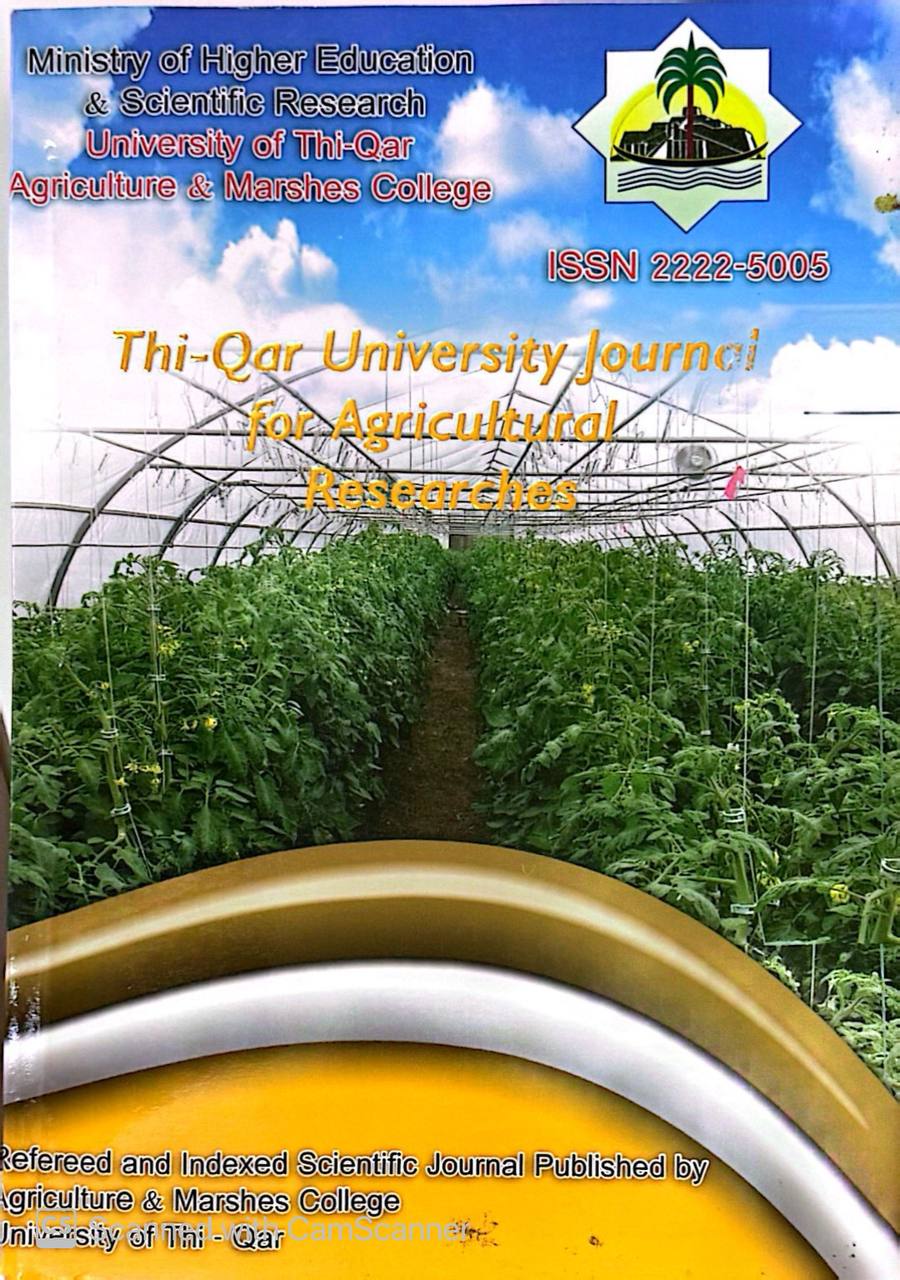Inhibitory Potential of Bacteriocins from Corynebacterium, Staphylococcus, and Bacillus sp. Against Multiple Resistant Bacterial Reference: A Comparative Study with Antibiotics
DOI:
https://doi.org/10.54174/utjagr.v13i1.308Keywords:
Antimicrobial agent, Antibiotic resistance, Bacteriocins, Corynebacterium sp., Staphylococcus sp., and Bacillus sp.Abstract
Bacteriocins are antimicrobial peptides produced by bacteria that can function as an alternative to conventional antibiotics. The main objective of this work is to utilize bacterial metabolic products as an alternative to antibiotics. This study assessed the inhibitory capacity of bacteriocins obtained from Bacillus sp., Corynebacterium sp., and Staphylococcus sp. against various antibiotic-resistant bacterial infections. Bacteriocins were isolated and refined from Corynebacterium sp., Staphylococcus sp., and Bacillus sp. They were later employed as antibiotic compounds against pathogenic bacterial strains which are including Enterococcus faecalis ATCC 29212, Klebsiella pneumoniae ATCC 4352, Escherichia coli ATCC 25922, Bacillus cerus ATCC 11778, Pseudomonas aeroginosa ATCC 27853, Micrococcus luteus ATCC 9341, and Staphylococcus aureus ATCC 65389, that were isolated from clinical specimens and identified as pathogenic species and antibiotics resistant. Additionally, a total of five antibiotics were utilized as controls against the tested isolates. These antibiotics include Ampicillin (10 µg), Spectinomycin (25 µg), Streptomycin (10 µg), Meropenem (10 µg), and Penicillin (10 µg). The broth dilution method was employed in a 96-well microtiter plate for bacteriocins, while the Kirby-Bauer disc diffusion method was used for antibiotics. The results indicated that the bacteriocins synthesized by all three species possess antibacterial activity exclusively against Escherichia coli ATCC 25922 and Micrococcus luteus ATCC 9341, suggesting their potential as alternatives to conventional antibiotics. Nevertheless, their influence on other microorganisms that tested was not observed. The antibacterial efficacy of bacteriocins can be affected by several factors, including the concentration of NaCl, temperature, bacterial enzymes, and pH level. The study revealed that the most favorable circumstances for the antibacterial efficacy of bacteriocins were a pH of 6, a temperature of 35℃, and a NaCl concentration ranging from 1.5M to 2.5M.
Downloads
References
Bilgehan, H. (2004): Clinical Microbial Identification, Barış Yayınları, Ankara, Türkiye.
Hammer, K.A., Carson, C.F., and Riley, T.V. (1999): Antimic¬robial Activity of Essential Oils and Other Plant Extracts. Journal of Applied Microbiology 86: 985-990.
Heredia-Castro, P. Y., Méndez-Romero, J. I., Hernández-Mendoza, A., Acedo-Félix, E., González-Córdova, A. F., and Vallejo-Cordoba, B. (2015): Antimicrobial activity and partial characterization of bacteriocin-like inhibitory substances produced by Lactobacillus spp. isolated from artisanal Mexican cheese. Journal of Dairy Science, 98(12), 8285-8293.
Jay, M.J. (1986): Modern Food Microbiology, Fermented Foods and Related Products of Fermentation, 3th ed., Van Nostrand Reinhold Company, New York, 239-406, 1986.
Madigan, M.T., Martinko, J.M., Stahl, D.A., Clark, D.P., (2012): Brock Biology of Microorganisms, 13th ed. Pearson, Global Edition.
Rajesh, D., Karthikeyan, S., and Jayaraman, G., (2012): Isolation and partial characterization of a new bacteriocin from Bacillus pumilus DR2 isolated from sea water. CIBTech Journal of Microbiology1, 2319-3867.
Riley, M.A., and Wertz, J.A. (2002): Bacteriocins: Evolution, Ecology and Application. Annu. Rev. Microbiol. 56, 117-37.
Rohban, R., Amoozegar, M.A., and Ventosa, A. (2009): Screening and Isolation of Halophilic Bacteria Producing Extracellular Hydrolyses from Howz Soltan Lake, Iran. J. Ind. Microbiol. Biotechnol. 36, 333-340.
Valentine, D.L., (2007): Adaptations to energy stress dictate the ecology and evolution of the Archaea. Nature Rev Microbiol; 5: 316-323.
Vasavada SH, Thumar JT, Singh SP., (2006): Secretion of a potent antibiotic by salt-tolerant and alkaliphilic actinomycete Streptomyces sannanensis strain RJT-1. Curr Sci; 91: 10-25.
Ventosa, A., Nieto, J.J., and Oren, A., (1998): Biology of Moderately Halophilic Aerobic Bacteria. Microbiol. Mol. Biol. Rev. 62, 504-544.
Williams, K., (2009): Biosurfuctants for cosmetic application: Overcoming production challenges. MMG Basic Biotech; 5: 1.
SY, J., KUMARS, A., YS, S., and MB, S., (2013): Culturable Diversity of Extremely Halophilic Bacteria from West Coast Of Karnataka, India. IJBPAS, February, 2013, 2(2): 391-405.
Price, L.B., Shand, R.F., and Halocin S. (2000): A 36-amino-acid microhalocin from the haloarchaeal strain S8a. J. Bacteriol. 182, 4951-4958.
Gutiérrez-Arnillas, E., Rodríguez, A., Sanromán, M.A., Deive, F.J., (2016): New Sources of Halophilic Lipases: Isolation of Bacteria from Spanish and Turkish Saltworks, Biochemical Engineering Journal, 109, 170-177.
EUCAST, European Committee for Antimicrobial Susceptibi¬lity Testing of the European Society of Clinical Microbiology and Infectious Diseases (ESCMID) (2000): Determination of minimum inhibitory concentrations (MICs) of antibacte¬rial agents by agar dilution, EUCAST Definitive Document E. Def 3.1, Clinical Microbiology and Infection, 6, 509-515.
Caglayan, P., (2018b): Minimum Inhibition Concentration of an Antimicrobial Agent Containing Methylisothiazolinone Used in Leather Industry against reference Strains, S.Ü. Fen Fakültesi Fen Dergisi. 44 (2): 149-156.
Abdulhusein S.H., Caglayan, P., Birbir, M., and Birbir, Y., (2023): Negative Effects of Haloversatile Bacteria in Salt on Skins and Their Control with Direct Electric Current in the Leather Industry” Journal of the Society of Leather Technologists and Chemists, ISSN 0144-0322, Vol. 107, Num. 6, 2023, pages 201-214.
Jack, R.W., Tagg, J.R., and Ray, B. (1995): Bacteriocins of Gram-positive bacterial, Microbiological Reviews, 59, 171-200.
Caglayan, P., and Birbir, M. (2018): Screening of Bacteriocin Production from Moderately Halophilic Skin Isolates to Inhibit Moderately Halophilic Bacteria Producing Protease and Lipase, JALCA, VOL. 113.
Hacker, C., Christ, N.A., Duchardt-Ferner, E., Korn, S., Göbl, C., Berninger, L., Düsterhus, S., Hellmich, U.A., Madl, T., and Kötter, P. (2015): The solution structure of the lantibiotic immunity protein NisI and Its interactions with Nisin. Journal of Biological Chemistry, 290, 28869-28886.
Abdulhusein, H.S. (2023): Investigation of Antibiotic Resistance, Bacteriocin and Enzyme Production of Haloversatile Bacteria in Salt Used For Skin Preservation, Controlling with an Antimicrobial Substance, doctorate thesis, Marmara university. Department of Microbiology; Istanbul, Turkey.
Azemin, A., Klappa, P., Mohd Shahir Shamsir Omar, M.S. (2015): Bacteriocin isolated from Halomonas sp. A Bacterial Ding Protein, Malaysian Journal of Analytical Sciences, 4(19), 831-840.
Moradi, M., Molaei, R., Guimarães, J.T. (2021): A review on preparation and chemical analysis of postbiotics from lactic acid bacteria. Enzyme and Microbial Technology, 143, 109722. enzmictec.109722.

Downloads
Published
Issue
Section
License
Copyright (c) 2024 Haider Sabah, Baidaa Mezher Kadim

This work is licensed under a Creative Commons Attribution-NonCommercial-ShareAlike 4.0 International License.







1.png)

